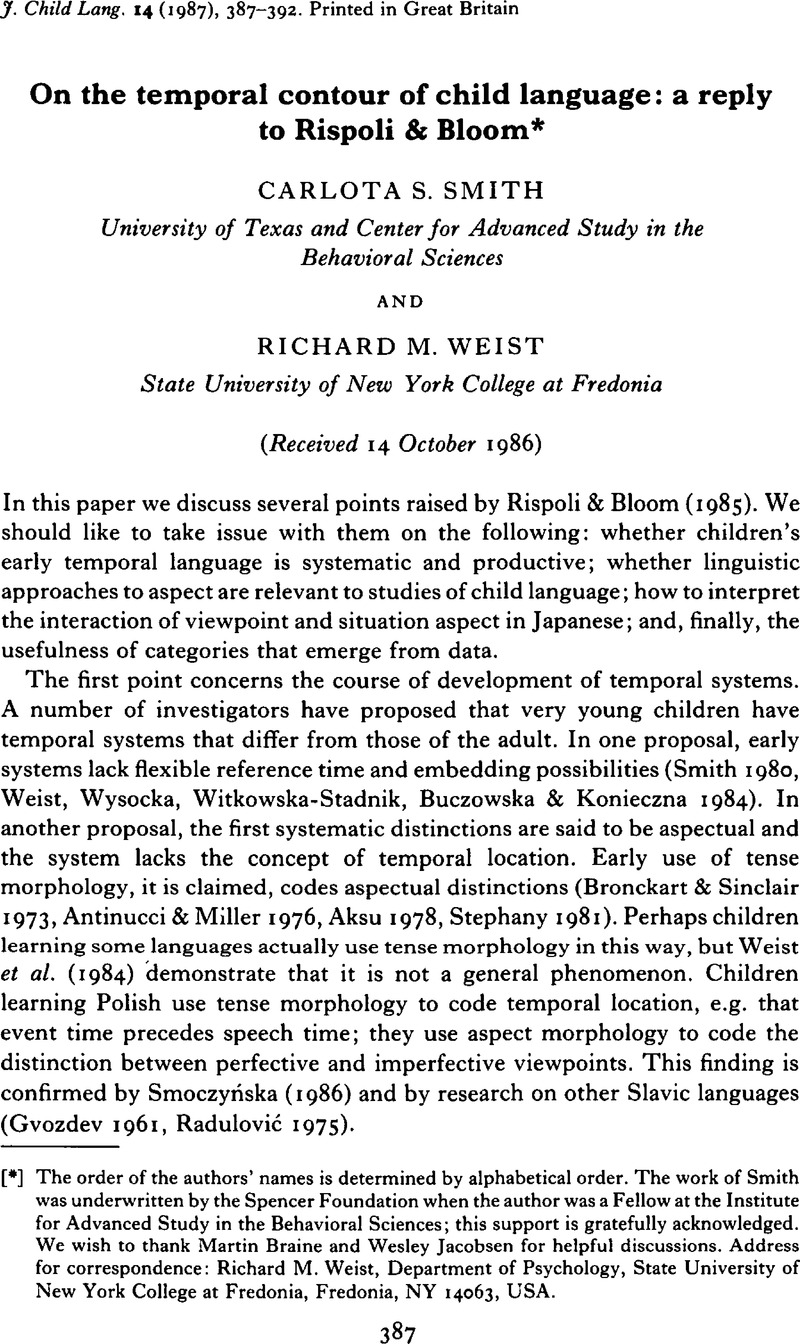Crossref Citations
This article has been cited by the following publications. This list is generated based on data provided by Crossref.
Weist, Richard M.
and
Buczowska, Ewa
1987.
The emergence of temporal adverbs in child Polish.
First Language,
Vol. 7,
Issue. 21,
p.
217.
Youssef, Valerie
1988.
The language bioprogram hypothesis revisited.
Journal of Child Language,
Vol. 15,
Issue. 2,
p.
451.
Weist, Richard M.
1989.
Aspects of the roots of language: commentary on Cziko.
First Language,
Vol. 9,
Issue. 25,
p.
45.
Bloom, Lois
and
Harner, Lorraine
1989.
On the developmental contour of child language: a reply to Smith & Weist.
Journal of Child Language,
Vol. 16,
Issue. 1,
p.
207.
Weist, Richard M.
1989.
Time and Human Cognition: A Life-Span Perspective.
Vol. 59,
Issue. ,
p.
63.
Herman, Rosalind
1990.
How do deaf speakers talk about time?.
Clinical Linguistics & Phonetics,
Vol. 4,
Issue. 3,
p.
197.
Rispoli, Matthew
1990.
Lexical assignability and perspective switch: the acquisition of verb subcategorization for aspectual inflections.
Journal of Child Language,
Vol. 17,
Issue. 2,
p.
375.
Buczowska, Ewa
and
Weist, Richard M.
1991.
The Effects of Formal Instruction on the Second‐Language Acquisition of Temporal Location*.
Language Learning,
Vol. 41,
Issue. 4,
p.
535.
Rispoli, Matthew
1991.
The acquisition of verb subcategorization in a functionalist framework.
First Language,
Vol. 11,
Issue. 31,
p.
41.
Weist, Richard M.
Wysocka, Hanna
and
Lyytinen, Paula
1991.
A cross-linguistic perspective on the development of temporal systems.
Journal of Child Language,
Vol. 18,
Issue. 1,
p.
67.
Rispoli, Matthew
1991.
The mosaic acquisition of grammatical relations.
Journal of Child Language,
Vol. 18,
Issue. 3,
p.
517.
Fayol, Michel
Hickmann, Maya
Bonnotte, Isabelle
and
Gombert, Jean Emile
1993.
The effects of narrative context on French verbal inflections: A developmental perspective.
Journal of Psycholinguistic Research,
Vol. 22,
Issue. 4,
p.
453.
Andersen, Roger W.
and
Shirai, Yasuhiro
1994.
Discourse Motivations for Some Cognitive Acquisition Principles.
Studies in Second Language Acquisition,
Vol. 16,
Issue. 2,
p.
133.
Andersen, Roger W.
and
Shirai, Yasuhiro
1996.
Handbook of Second Language Acquisition.
p.
527.
Ping Li
and
Bowerman, Melissa
1998.
The acquisition of lexical and grammatical aspect in Chinese.
First Language,
Vol. 18,
Issue. 54,
p.
311.
McCormack, Teresa
and
Hoerl, Christoph
1999.
Memory and Temporal Perspective: The Role of Temporal Frameworks in Memory Development.
Developmental Review,
Vol. 19,
Issue. 1,
p.
154.
Shirai, Yasuhiro
2000.
The semantics of the Japanese imperfective -teiru: An integrative approach.
Journal of Pragmatics,
Vol. 32,
Issue. 3,
p.
327.
2000.
The Acquisition of Lexical and Grammatical Aspect.
Labelle, Marie
2009.
Acquisition de la valeur des temps du passé par les enfants francophones.
Revue québécoise de linguistique,
Vol. 23,
Issue. 1,
p.
99.
Smith, Carlota S.
2009.
Text, Time, and Context.
Vol. 87,
Issue. ,
p.
225.



